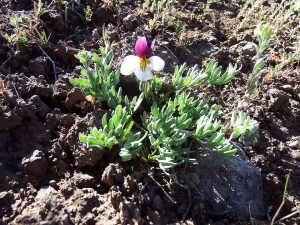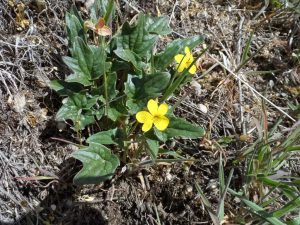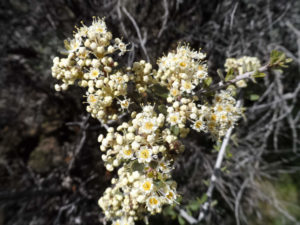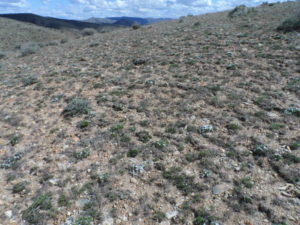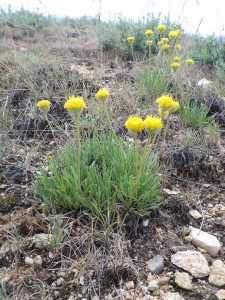COBB TRAIL WILDFLOWER WALK
mid April to mid May
F
Description: This is one of the more challenging of the recommended wildflower walks, approximately 4 miles roundtrip (out and back) with 1000 foot elevation gain, on a (mostly) well-graded road. The goal is an uncommon “windswept ridge” habitat, with other interesting plants en route.
NOTE: Please enjoy the wildflowers and leave them for others to enjoy. Because our unique local flora is already under pressure from invasive weeds and habitat loss, harvesting of native plants is not encouraged on this website, especially along popular trails.
The walk begins at Highland Valley trailhead at the end of West Highland Valley Road off of east Warm Springs Road, in the East Valley development of Harris Ranch. Follow the West Highland Valley trail about 1/3 mile, taking note of shrubs and flowers along the roadside bank. Turn left on Cobb Trail, which immediately drops down to a small shrub-lined creek. There is a good diversity of wildflowers on the relatively intact north-facing slope above the creek, including the lovely longspur (“polychrome”) lupine (Lupinus arbutus).
About another 1/3 mile from the creek crossing, the trail traverses a ridge where the recently described Andrus’s biscuitroot (Lomatium andrusianum) grows. This plant had previously been shoe-horned into nine-leaved biscuitroot (Lomatium triternatum), but recent molecular work by botanists at Boise State University and The College of Idaho showed that it was a distinct species. In an attempt to generate funds to continue their research on Lomatium, the “naming rights” for the new species were auctioned off, with the winning bid choosing to honor former Idaho governor Cecil D. Andrus.
From the ridgeline, the trail traverses a west-facing slope where sharp eyes can sometimes spot the early-blooming Beckwith’s violet or sagebrush pansy (Viola beckwithii) and goosefoot violet (Viola purpurea ssp. venosa). An old homestead is encountered at about 1.5 miles from the trailhead, recognized by the naturalized grove of black locust (Robinia pseudoacacia, not in bloom until mid summer) and associated weeds growing around a spring.
A couple of hundred feet north of the homestead area, mostly on the south side of the trail, look for rigidly branched white-flowered shrubs whose presence in the Boise foothills is a bit of a head-scratcher. This the Mojave ceanothus (Ceanothus vestitus), growing a long way from its Mojave Desert home. This is presumably one of the survivors of experimental plantings by the Rocky Mountain Research Station in the 1960’s and 1970’s when the goal was to improve deer winter range, with a focus on growth rates, protein content, winter leafiness, and palatability, but little regard for native range except the western US in general. There are also a couple of Apache plume (Fallugia paradoxa) from the same origin, but not doing as well as the ceanothus. Bitterbrush (Purshia tridentata) planted in rows on the hillside above are further evidence of experimental plantings.
The final half mile ascent (ca 400 feet elevation gain) is relatively steep and rocky; hiking poles recommended if so inclined. The reward is both fine views and an entirely new suite of plants on the wind-swept knoll. Although the summit is tempting, please stay on the path, since this seemingly barren site is actually a delicate habitat. If your timing is right, you’ll be able to enjoy both tufted carpet phlox (Phlox caespitosa) and scabland fleabane (Erigeron bloomeri).
From this point, you can either retrace your steps, or else continue on a 5.7 mile loop via Lucky Peak and West Highland Valley trails (described in reverse in Scott Marchant’s The Hiker’s Guide: Greater Boise).
PLANT LIST [updating needed]
NOTE: Please enjoy the wildflowers and leave them for others to enjoy. Because our unique local flora is already under pressure from invasive weeds and habitat loss, harvesting of native plants is not encouraged on this website, especially along popular trails.
Plants listed in approximate order of occurrence within category; some might not yet be in bloom, or present during a particular year. * indicates native
WILDFLOWERS POTENTIALLY IN BLOOM
- Stork- or cranesbill, filaree (Erodium cicutarium) – non-native
- Desert alyssum(Alyssum desertorum) and/or pale alyssum (Alyssum alyssoides) – widespread non-natives, difficult to tell apart; also called madwort
- *Fiddleneck (Amsinckia spp.) – species difficult to distinguish
- *Woolly-pod milkvetch (Astragalus purshii var. glareosus)
- *Barestem biscuitroot, pestle-parsnip(Lomatium nudicaule)
- Jagged chickweed (Holosteum umbellata) – inconspicuous non-native
- *Smallflower woodlandstar/prairiestar (Lithophragma parviflorum)
- Spring whitlow-grass (Draba verna) – tiny white flowers with notched petals
- *Longleaf phlox (Phlox longifolia) – intergrading with more compact pricklyleaf phlox (Phlox aculeata) in Boise foothills
- *Slender phlox (Microsteris gracilis var. humilior)
- *Arrowleaf balsamroot (Balsamorhiza sagittata)
- *Miner’s lettuce(Claytonia/Montia perfoliata, possibly also C. rubra)
- *Ballhead waterleaf (Hydrophyllum capitatum)
- *Narrowleaf or Great Basin biscuitroot (Lomatium simplex, previously included in L. triternatum as ssp. platycarpum, nine-leaf biscuitroot)
- *Longspur or polychrome lupine(Lupinus arbustus [= L. laxiflorus in older references])
- *Western or intermediate dogbane (Apocynum floribundum) – not in bloom, but noteworthy]
- *Cleavers, bedstraw, stickywilly, goose-grass (Galium aparine)
- *Dwarf or low pussytoes (Antennaria dimorpha)
- *Andrus’s biscuitroot (Lomatium andrusianum, previously included in L. triternatum or L. ambiguum)
- *Beckwith’s violet, sagebrush pansy (Viola beckwithii)
- Corn gromwell(Buglossoides/Lithospermum arvensis)
- *Goosefoot violet (Viola purpurea ssp. venosa)
- *Bulbous or early woodlandstar/prairiestar (Lithophragma glabrum, formerly L. bulbiferum)
- *Popcorn-flower (Plagiobothrys tenellus)
- *Tansymustard (Descurainia sp.) – native species difficult to distinguish, taxonomy in flux
- *Carpet or Hood’s phlox (Phlox caespitosa )
- *Scabland fleabane(Erigeron bloomeri var. bloomeri)
SHRUBS AND TREES (mostly not in bloom)
- Black locust (Robinia pseudoacacia) – non-native tree
- *Basin big sagebrush (Artemisia tridentata ssp. tridentata)
- *Rubber rabbitbrush (Ericameria [formerly Chrysothamnus] nauseosa) — var. hololeuca is the more common larger variety; the smaller, more spindly var. oreophila is mostly on plateaus
- *Bitterbrush, Antelope brush(Purshia tridentata)
- *Willows(Salix spp.) – several species locally, most are difficult to distinguish
- *Syringa or Lewis’s mockorange(Philadelphus lewisii)
- *Golden currant(Ribes aureum)
- *Interior or Wood’s rose (Rosa woodsii ssp. ultramontana) – native, with slender prickles
- *Mountain big sagebrush (Artemisia tridentata ssp. vaseyana)
- Mohave ceanothus (Ceanothus [greggii var.] vestitus) – intentionally introduced non-native
- Apache plume(Fallugia paradoxa) – intentionally introduced non-native, locally persisting
PRIMARY BUNCHGRASSES (not all in bloom, but evident)
- Bulbous bluegrass (Poa bulbosa) – weedy non-native
- Tall or rush wheatgrass (Thinopyrum ponticum; alternatively in Agropyron, Elymus, Elytrigia) – intentionally introduced non-native
- Crested wheatgrass(Agropyron cristatum) – widely planted non-native
- *Bluebunch wheatgrass (Pseudoroegneria spicata, alternatively in Agropyron or Elymus) – both native-to-site and planted races from other sites probably present
- *Threeawn grass (Aristida purpurea var. longiseta)
- *Squirreltail grass(Elymus elymoides, formerly Sitanion hystrix)
- *Sandberg bluegrass(Poa secunda)
- *Idaho fescue(Festuca idahoensis)
SIGNIFICANT NOXIOUS WEEDS (mostly not yet in bloom, but evident)
- Whitetop (Lepidium [previously Cardaria] draba)
- Rush skeletonweed (Chondrilla juncea)
- Cheatgrass (Bromus tectorum) — other annual Bromus also present
- Medusahead grass (Taeniatherum/Elymus caput-medusae)
- Bur buttercup (Ceratocephalus/Ranunculus testiculata)

